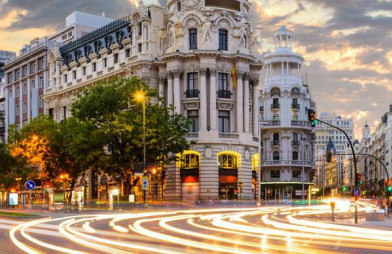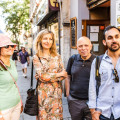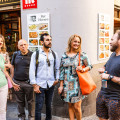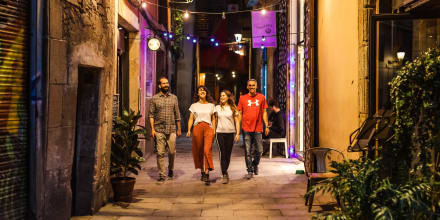
By Matthew Wears
If you were to imagine a holiday in Spain you would be forgiven for only conjouring up images of baking hot summer days spent lounging around a pool with plenty of factor fifty. Spain’s weather year round is normally fairly consistent, with mild winters making it a very popular destination for those seeking some much needed winter sun. But the vibrant and energetic capital city Madrid offers a far more varying range of temperatures due to its high altitude and close proximity to Sierra de Guadarrama National park. Shoulder seasons Autumn and Spring offer a more temperate climate, and it is therefore no surprise that these are the most popular times for visitors.

With such a variety of things to do in Madrid and because there are celebrations and experiences to be had all year round there really isn’t a clear best time to visit Madrid, it all depends on what you want to see! Whether you fancy a weekend winter break spending 2 days soaking up art and culture or a relaxing summer trip sat in cool rooftop swimming pools and bars, there really isn’t a bad time to visit the Spanish capital. If you’re searching for some information on when to visit Madrid, then hopefully this monthly breakdown can give you some much needed inspiration.

January – February
The beginning of the year is going to be cold, so make sure you pack a warm coat. Average January temperatures are just five degrees Celsius, and during the night it can often drop close to freezing. If you can put up with the cooler Madrid weather though you will still be blessed with a majority of bright and sunny days as rainfall is low all year round. With Christmas and New Year celebrations coming to an end, the city will feel the quietest it has all year. These months see the lowest number of visitors so if you want an experience without the hustle and bustle of peak season then this definitely a good time to go.

Although quiet, January still hosts one of the major celebrations in the Spanish calendar; The Three Kings Parade. Held on January the 5th of every year, the day preceding three Kings Day, the ceremony involves highly decorated and ornate floats being towed through the streets whilst the Three Wise Men throw sweets into the excited crowds below. The procession ends at the square of Cibeles where there is an extravagant stage show complete with pyrotechnics. As it offers a unique insight into Spanish culture, it is always a busy time, so booking in advance to avoid high prices is highly recommended. Later on into February, why not make the most of quieter streets and take a laidback stroll down the magnificent Gran Vía with some fresh churros and chocolate sauce.

March – April
This is a period of transition for Madrid, with the coolness of winter being replaced by the initial warm days of spring. The weather during March will be considerably warmer than the months that came before however, and with some of the lowest levels of rainfall it makes for one of the best times to visit Madrid. It is towards the end of April that temperatures start to touch the low twenties, and the anticipation of summer begins to sweep across the city. Terrazas begin to stir from winter hibernation and the many parks that are dotted around the city start to bloom and become perfect places to spend lazy, warm afternoons.

As the cities green spaces begin to blossom, so to do Madrid’s cultural celebrations. These months see a handful of notable events, from music and film all the way to performance and arts. Noche de los Teatros (or World Theatre Day) is a major celebration in Madrid, and sees hundreds of performances taking place all across city in the afternoon and evening of the 25th March. Just a few days before on the 19th and 20th of March, the MadrEAT Street Food Market will open its doors again and unveil a selection of culinary delights from around the world. Food vans containing Asian, European and African flavours park up just outside of the Moda shopping centre for one big celebration of food in the capital.

May – June
After a gradual transformation from the cold winter months, the first real taste of summer arrives in the city. The days are almost at their longest and the only thing that breaks up the sunshine is the occasional thunderstorm, and although far from an everyday occurrence due to low levels of humidity, you might just find yourself running for cover! The temperature at this time of year is perfect as the full brunt of the oppressive hot summer heat is not yet at its peak. This makes it a perfect time to come for sightseeing, but be warned, nearing summertime towards the end of June will see the arrival of many more tourists.

May starts off with not one but two back to back public holidays, the second of which is known as the Day of Madrid and is a city exclusive. This feels like the beginning of summertime as many locals begin to move outside and enjoy eating, drinking and socializing in the many plazas and squares. One of the cities most important regional celebrations, San Isidro, commences on the 11th May and lasts for four days. The festivities are in honour of the patron saint of the city and offer a truly unique insight into historic Madrid customs. Locals perform traditional dancing known as Chotis and feast on local delicacies in tribute to one of the cities most beloved historical figures. June continues the traditional celebratory theme with both major flamenco and bullfighting festivals all taking place across the city.

July – August
July and August sees the arrival of the searing heat of summertime in Madrid where average temperatures are around the low thirties, but peaks all the way into the forties are certainly not uncommon. It is recommended that you book a hotel with a pool area to cool off in and opt for more leisurely activities during the day such as lounging in the parks or sipping cocktails in one of the endless bars. The cities high elevation means that nights are still cool, so sitting out and enjoying an evening drink is still the perfect way to close out on a day of sightseeing in the intense heat. These months are however by far the busiest months of the year, so if queuing isn’t your thing perhaps think about going a little further out of season.

Because of the heat the celebrations die down during this period, but there is still loads to do and get involved with. An interesting place to take refuge from the heat would be one of the cities many museums such as The Prado or The Reina Sofía. An added bonus is that during summertime most galleries put on some amazing exhibitions. Both are open all week from 10AM until 7.30PM and 9PM respectively, although on Sundays a little earlier. If you want a glimpse of traditional Madrid culture, then there is no better place than at a colourful and fiery Fiesta. Also known as Verbenas, the most popular La Paloma takes place from the 12th to the 15th of August.

September – October
As the nights get noticeably shorter the temperature begins to lower back down to a comfortable level. Although September can still see warm weather especially at the beginning, it is no where near the scorching highs of the previous months. October brings overcast days that are milder still, and often brings with it the return of the winter rains. As the city cools, it seems to wake from its summer siesta and life begins to spring back into the streets of Madrid.

In terms of festivals and events there is not a wide selection in this period. During the first days of September you can still catch the final performances from Veranos de la Villa, the sprawling summer festival that contains music, performance and dance. October offers a time of calm in between the frantic summer days and the beginning of the run up to Christmas. Make the most of the time with minimum tourists and explore some of the cities most popular land marks such as the grand baroque beauty of the Royal Palace or sit and admire a somewhat calmer Plaza Mayor, the ever beating heart of the capital city. Or if you have seen all of the main tourist sights, try discovering some of the city's hidden gems or take a look around Malasaña, a trendy neighbourhood bursting with independent boutiques and quirky bars as well as a huge selection of Spanish street art. It can be reached by bus or metro, just get off at the Tribunal stop on the main street Calle Fuencarral.

November - December
With the beginning of the winter months comes the return of the cold winter weather. Temperatures are back down to a chilly ten degrees and it’s definitely time to bring your warm jacket. Rain becomes more frequent but never overly common, and even frost and snow have been known to occur later in December. The excitement of Christmas begins to build and the tourists begin to flood back into the city for the holiday season, bringing with them the all to familiar buzz that encompasses the city most of the year.

As with most European cities, one of the main draws during the festive periods are Christmas markets. There are many dotted around the city but the main one would have to be the spectacular Plaza Mayor, where lights and decorations line the beautiful architecture and stalls selling Spanish wine, churros and hot chocolate offer a perfect break from the festive busyness. If you want to do a spot of Christmas shopping then there is no better place to go than the Puerta del Sol, one of the most vibrant and energetic places in the entire city. With hundreds of shops and boutiques to choose from you can be sure you will find all the right gifts here. In Spain the Christmas period is a time to indulge in some of the finest food and drinks you can get your hands on. So why not follow the locals’ lead and try some of the many Spanish favourites such as Turrón or seafood, both of which play an important role in Spanish Christmas cuisine.

When is the best time to visit Madrid?
Madrid is a city famous for its ongoing parade of celebrations, festivals and cultural activities. Many of these occur all throughout the year so choosing a specific time to visit totally depends on what you want to see. The high temperatures of summer are best avoided unless you can brave both the heat and crowds to catch some of the summer festivals. Springtime is a great choice, with perhaps May being the best time of the year to visit Madrid as it is not yet peak season, temperatures are just right and there is an absolute abundance of events taking place all across the city. Locals begin to go outside and plazas begin to fill with beautiful bars and restaurants that make for a typically Spanish social experience.
Hey curious traveler, visiting Madrid soon? Hey curious traveler, visiting Madrid soon? At City Unscripted, we create personalized city experiences led by passionate locals who share Madrid’s stories in a way no guidebook can. Whether you’re seeking hidden gems or exploring iconic landmarks, your experience is flexible and designed just for you — without the rigid structure of a tour. Discover the culture, history, and character of Madrid with a host who adapts the journey to your interests, making every moment feel unique and unscripted.
Top private experiences in Madrid
We’ll pair you with the perfect host
There is no better way to see a city than with a friend who lives there. This is why we carefully match guests with their perfect host based on interested, personality and type of experience so they can discover a city beyond the tourist trail.
























